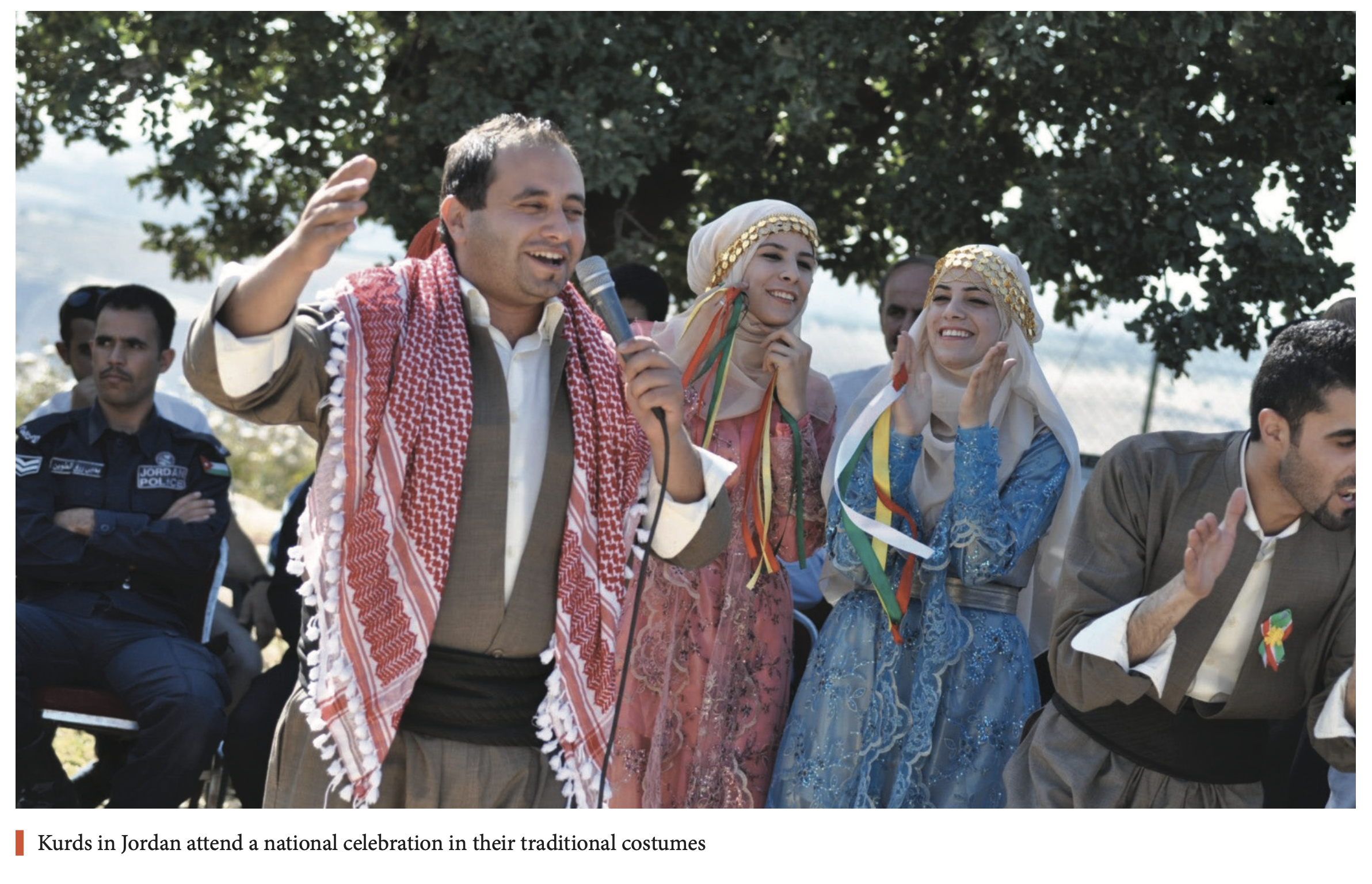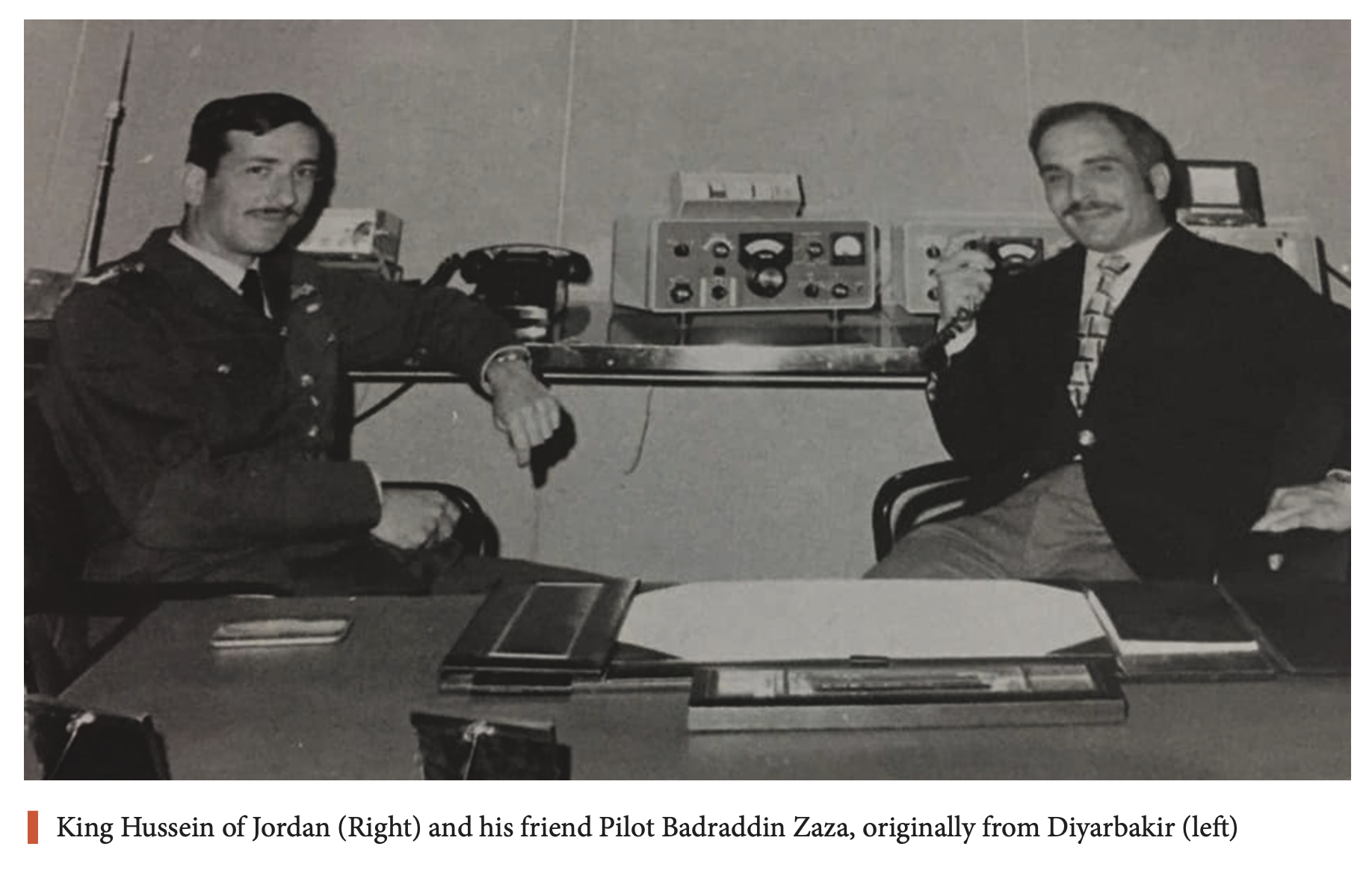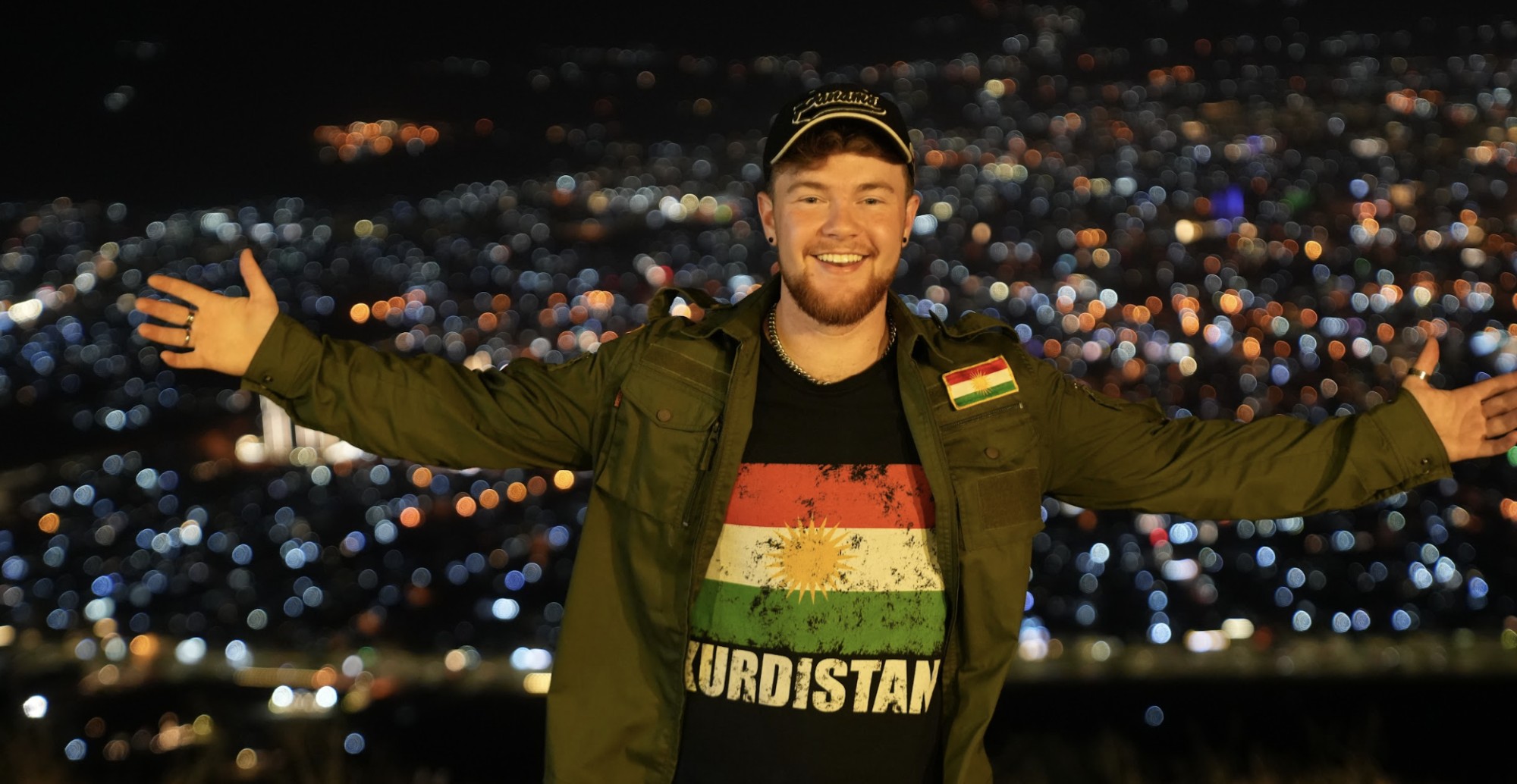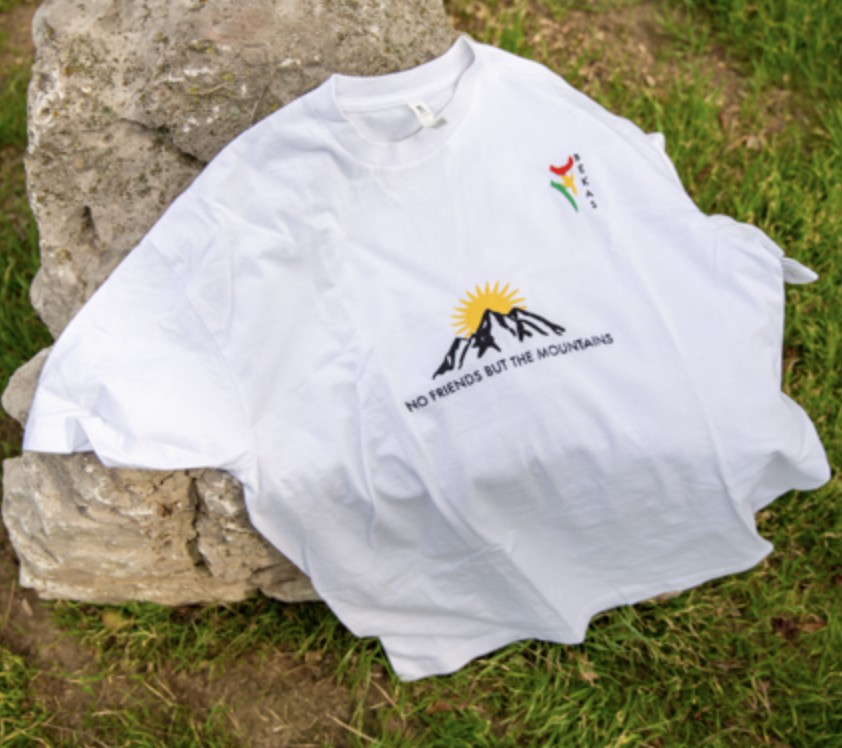In Jordan today, there is a Kurdish minority population estimated at thirty thousand people, which includes Kurds who settled in the Jordanian territory in the last quarter of the nineteenth century and the first quarter of the twentieth century, as well as Kurds from Palestine who sought refuge after 1948 and 1967.
Historical sources indicate that the Kurds have settled in Jordan since the beginning of the Ayyubid era and continued to do so in the Mamluk, Ottoman, and modern eras. Kurds have been living in the city of As-Salt located west of Amman since the early Ayyubid era, and their neighborhood (Harat Al-Kurd, meaning suburb of the Kurds) is still there and serves as a well-known landmark of the geographical, historical and tribal divisions of As-Salt. In fact, half of the tribes of As-Salt are attributed to the neighborhood and are known by it.
Today, Jordanian Kurds live in many cities and villages and have formed with time a part of the Jordanian social, political and economic fabric. Alongside Jordanians, Kurds have greatly contributed in building modern Jordan, which was founded by the late King Abdullah bin Al-Hussein.
Several factors have contributed to the harmony of the Kurds with the Jordanians: the similarity of customs and traditions, religion, geographical proximity – Kurdistan’s borders closely align to and overlap with Mesopotamia and Greater Syria (the Levant) – intermarriage and lineage, and common history. This harmony, however, does not prevent the Kurds from saying that they constitute an “ethnic minority” like other minorities in Jordan, including the Armenians, Chechens, and Circassians. The Kurds of Jordan also have cousins, relatives, and in-laws in Kurdistan, the home of their ancestors.

Historical overview
As mentioned above, historical sources trace the arrival of Kurds in Jordan to the beginnings of the Ayyubid dynasty, which was founded by the famous Kurdish leader Salah al-Din al-Ayyubi (Saladin) in 1173. The Kurds, who came from Kurdistan to the Levant and Egypt, formed the mainstay of his army. East Jordan, where Saladin’s forces were stationed, became the battlefield of the Ayyubid-Crusader conflict, with Saladin’s forces besieging the castles of the Franks in Karak and Shoubak and building Ajloun Castle on top of Mount Awf to monitor the movements of the Franks in the Jordan Valley.
Salah al-Din settled a group of Hakkari Kurds in his army in the city of As-Salt. That group played a prominent role in the Crusades from 1177-1189, and the neighborhood that they inhabited in As-Salt was named after them. Many scholars and judges emerged from the Hakkarian Kurds in As-Salt, including Abdullah al-Hakari As-Salti and his son Badr al-Din As-Salti, who studied at the Seifiya school in As-Salt. The latter worked as a judge in As-Salt, Jerusalem, Damascus, and Homs, where he died in 1384.
Some Hakkari Kurds also moved from As-Salt to Jerusalem during the Mamluk era and formed a neighborhood of their own known as Haret As-Saltiya, which was named after As-Salat from where they hailed. In Jerusalem, they became imams of Al-Aqsa Mosque for a long period of time and are known today in Jerusalem as the Imams.

Ayyubid, Mamluk, and Ottoman eras
During the Ayyubid era, King Al-Nasir Dawood Al-Ayyubi established in 1229 what is known as the Ayyubid Emirate of Karak, which lasted about eighty years and was based on the current site on which the Hashemite Kingdom of Jordan is based today. With his army, Al-Nasser Dawood was able to repel the Crusaders and liberate Jerusalem from their grip again in 1239. Through building schools, Al-Nasser Dawood also stimulated the scientific and cultural movement in Jordan whereby Karak became a destination for religious men and scholars. The Kurdish Ayyubids in Jordan have left prominent archaeological landmarks such as the Ajloun citadel and As-Salt citadel, which was destroyed in 1840, as well as the Great Mosque of Ajloun and the Reemon Mosque in Jerash.
During the Mamluk era (1260- 1516), the Kurds continued to settle in their neighborhood in the city of As-Salt, with some studying at the Seifiya School, including Abdullah al-Hakari, his son Badr al-Din, and the Kurdish faqih (an expert in Islamic jurisprudence) Shihab al-Din bin Suleiman al-Kurani.
Ottoman records mention the presence of a Kurdish neighborhood in As-Salt in the years 1538 and 1596, providing clear evidence of the continuation of Kurdish settlement in the region despite the migration of some Hakkarian Kurds from As-Salt to Jerusalem in that period and later. The Kurdish neighborhood (mahalat Al-Kurds) remains a prominent geographical name in As-Salt from the Ayyubid era to the present day, so much so that no Arab or foreign traveler passed through it without mentioning the Kurdish neighborhood and its clans.

Late nineteenth century influx
In the last quarter of the nineteenth century, Kurds began to flow to Jordanian cities and villages in larger numbers, and the settlement of most Kurdish families in Jordan dates to this period. This influx may be attributed to the fact that the Ottoman Empire extended its administrative and military control over the region, which led to improvement in transportation methods and the establishment of security and order. Thus, most of the gendarmes, soldiers, administrative staff, and tax collectors in Jordanian cities and outposts were Kurds, who came from Kurdish neighborhoods in Damascus, Aleppo, the Jazira region, Mardin, or Diyarbakir. The Kurdish staff in Jordan specialized in collecting imperial funds and the taxation of tithes. In her book Irbid and its Neighborhood (1995), researcher Dr. Hind Abu Al-Shaar confirms that soldiery, gendarmerie, and tax collection agents during the Ottoman era were reminiscent of the Kurdish element.
In addition to the army and gendarmerie, many Kurds worked in administrative and governmental jobs in the centers of provinces and districts in Ajloun, Balqa, Karak, and Maan. Meanwhile, many Kurdish women from Salihiya in Damascus married Jordanian citizens, as indicated in the Ottoman legal records of Irbid, Ajloun, Amman, and elsewhere. At the end of the Ottoman era, commercial movement flourished among Damascenes and own trading businesses and other interests. After the defeat of the Turks in 1918, many Kurdish employees and soldiers returned to their countries, while others preferred to remain and reside in Jordanian cities.

Kurds and the establishment of Jordan
The Kurds of Jordan have made major contributions to the building and establishment of modern Jordan in the political, military, economic and cultural realms and left clear imprints on those fields, so much so that their participation exceeded those who outnumbered them.
For instance, two Kurdish officers Khalil Bakr Zaza and Nour al-Din al-Barzanji were among those who received His Highness Prince Abdullah bin Al-Hussein on his arrival to Ma'an in 1920. When Prince Abdullah came to Amman, the notable Sayyidou al-Kurdi, Ali al-Kurdi, and the leader Rashid al-Madfai – an Iraqi Kurd and one of the prominent leaders of the Great Arab Revolt – were among his recipients.
Officers of Kurdish origin were among the notable founders of the army and gendarmerie when Prince Abdullah bin Al-Hussein set out to establish the Jordanian army. In addition, many served in the army, gendarmerie, and police and attained various high-ranking positions throughout the Jordanian emirate and the later Jordanian kingdom. Some even reached the highest leadership positions in the army and the gendarmerie, including Rashid Al-Madfai as Director of Public Security in 1923 and Lieutenant General Saleh Al-Kurdi, who was Commander of the Jordanian Air Force and Assistant to the Commander-in-Chief of the jordanian Armed Forces from 1962-1971.

Some Kurds have also held high political positions in the government. For example, Mr. Rashid Al-Madfai was Minister of Interior and Defense in 1939, Saad Jumaa was Prime Minister twice in 1967, Engineer Salah Jumaa was Minister of Agriculture and Supply from 1967-1979, Dr. Youssef Zahni was appointed as Minister of Social Affairs and Labor in 1973, Saad Eddin Jumaa held the position of Secretary General of the Jordanian Prime Ministry for decades and was Minister of State for Prime Ministry Affairs, and Dr. Ashraf Al-Kurdi was Minister of Health and a notable figure in the Jordanian Senate.
In diplomacy, Mr. Ali Seydo Al-Kurdi was Minister Plenipotentiary in the Ministry of Foreign Affairs and served in the Jordanian embassies in Ankara, Damascus, Jeddah and Yemen. Mr. Medhat Jumaa, on the other hand, was Jordan's ambassador to Britain, Morocco, Spain, Tunisia, West Germany, and the United States. Major General AbduIlah Al-Kurdi was Ambassador of Jordan to Malaysia and Russia, and Mr. Mazen Medhat Jumaa Ambassador to Malaysia.
Today, the Kurds of Jordan have a charitable social association named Salah al-Din al-Ayyubi Association that is located in Tlaa al-Ali, one of the prestigious areas of Amman.
Dr. Muhammad Ali Al-Swerki, a Jordanian national of Kurdish descent, is a distinguished individual with a PhD in Philosophy/Education and Curricula. He is an esteemed member of the Jordanian Writers and Writers Union and has been recognized for his contributions to the modern history of Jordan, receiving the State Encouragement Award.

